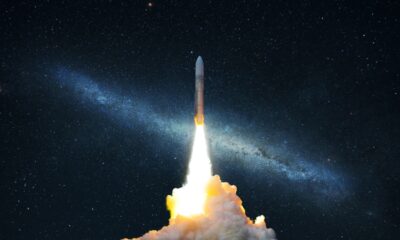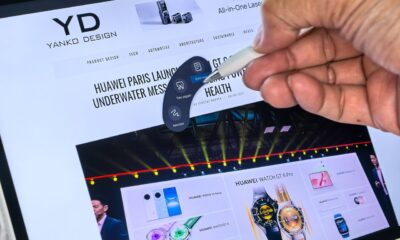Science
China’s Wukong Spacesuit Sets New Standard for AI in Space

China’s recent advancements in artificial intelligence (AI) have been underscored by the introduction of the Wukong spacesuit, which is designed to enhance operational efficiency during space missions. Named after the legendary figure Sun Wukong, also known as the Monkey King, the Wukong spacesuit incorporates advanced AI systems that offer real-time guidance and information, significantly improving the usability and performance of astronauts in challenging environments.
The Wukong spacesuit has made its debut as part of China’s efforts to further develop its capabilities in space exploration. The Tiangong Space Station, which serves as a critical research platform, has been identified as an ideal setting for testing this technology. Conducting spacewalks is a complex task that requires immediate and appropriate responses to an array of unpredictable situations. The capabilities demonstrated by the Wukong suit are seen as a vital step toward proving the practical applications of AI in space.
As AI continues to evolve, the current narratives surrounding its dominance often miss the mark. Many observers argue that terms such as “AI dominance” lack clear definitions, especially when contrasted with the ongoing development and operational strategies employed by organizations like NASA. While NASA has established a comprehensive AI program, its focus has primarily been on medical support rather than direct operational assistance in space missions.
The contrasting approaches of China and the United States in employing AI technologies highlight the need for a unified understanding of AI’s potential and limitations. The Wukong spacesuit exemplifies a move toward redefining what AI can accomplish in critical environments. It stands in stark contrast to the often simplistic portrayals of AI as mere chatbots or tools that rely heavily on human input for efficacy.
The implications of these developments extend beyond technical capabilities; they raise essential questions about the future of international collaboration in space exploration. With both nations advancing their technologies, a cooperative approach may yield significant benefits, allowing for shared insights and improved safety protocols in space.
As AI technology matures, it becomes increasingly evident that its true value lies in functionality and reliability. The Wukong spacesuit serves as a reminder that AI should be viewed as a critical tool, akin to fire or the wheel, rather than just another technological novelty. In the context of space exploration, where failures can have dire consequences, ensuring that AI systems are dependable is paramount.
In conclusion, the advancements represented by the Wukong suit could pave the way for a new era of AI applications in space missions. Both China and the United States have much to gain from focusing on collaboration rather than competition in this field. As stakeholders evaluate the future of AI in space, the emphasis must remain on achieving tangible results that enhance human safety and operational effectiveness.
-

 Education3 months ago
Education3 months agoBrandon University’s Failed $5 Million Project Sparks Oversight Review
-

 Science4 months ago
Science4 months agoMicrosoft Confirms U.S. Law Overrules Canadian Data Sovereignty
-

 Lifestyle3 months ago
Lifestyle3 months agoWinnipeg Celebrates Culinary Creativity During Le Burger Week 2025
-

 Health4 months ago
Health4 months agoMontreal’s Groupe Marcelle Leads Canadian Cosmetic Industry Growth
-

 Science4 months ago
Science4 months agoTech Innovator Amandipp Singh Transforms Hiring for Disabled
-

 Technology4 months ago
Technology4 months agoDragon Ball: Sparking! Zero Launching on Switch and Switch 2 This November
-

 Education4 months ago
Education4 months agoRed River College Launches New Programs to Address Industry Needs
-

 Technology4 months ago
Technology4 months agoGoogle Pixel 10 Pro Fold Specs Unveiled Ahead of Launch
-

 Business3 months ago
Business3 months agoRocket Lab Reports Strong Q2 2025 Revenue Growth and Future Plans
-

 Technology2 months ago
Technology2 months agoDiscord Faces Serious Security Breach Affecting Millions
-

 Education4 months ago
Education4 months agoAlberta Teachers’ Strike: Potential Impacts on Students and Families
-

 Education3 months ago
Education3 months agoNew SĆIȺNEW̱ SṮEȽIṮḴEȽ Elementary Opens in Langford for 2025/2026 Year
-

 Business4 months ago
Business4 months agoBNA Brewing to Open New Bowling Alley in Downtown Penticton
-

 Technology4 months ago
Technology4 months agoWorld of Warcraft Players Buzz Over 19-Quest Bee Challenge
-

 Business4 months ago
Business4 months agoNew Estimates Reveal ChatGPT-5 Energy Use Could Soar
-

 Business4 months ago
Business4 months agoDawson City Residents Rally Around Buy Canadian Movement
-

 Technology2 months ago
Technology2 months agoHuawei MatePad 12X Redefines Tablet Experience for Professionals
-

 Technology4 months ago
Technology4 months agoFuture Entertainment Launches DDoD with Gameplay Trailer Showcase
-

 Technology4 months ago
Technology4 months agoGlobal Launch of Ragnarok M: Classic Set for September 3, 2025
-

 Top Stories3 months ago
Top Stories3 months agoBlue Jays Shift José Berríos to Bullpen Ahead of Playoffs
-

 Technology4 months ago
Technology4 months agoInnovative 140W GaN Travel Adapter Combines Power and Convenience
-

 Science4 months ago
Science4 months agoXi Labs Innovates with New AI Operating System Set for 2025 Launch
-

 Technology4 months ago
Technology4 months agoNew IDR01 Smart Ring Offers Advanced Sports Tracking for $169
-

 Technology4 months ago
Technology4 months agoDiscover the Relaxing Charm of Tiny Bookshop: A Cozy Gaming Escape










